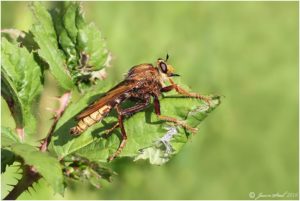Jason Steel, a leading local wildlife photographer, has captured a picture of the rare Hornet Robber Fly (Asilus crabroniformis), at Thames Road Wetland.
According to Buglife, this predatory species, which protects itself by resembling a Hornet, is thought to now breed in only 40 isolated sites in the UK. In any event it is thought to have declined by around 25% between 1980 and 2000 and is now a UK Biodiversity Action Plan species. It is said to be ‘arguably’ our largest fly at over an inch long.
https://www.buglife.org.uk/bugs-and-habitats/hornet-robberfly
Females lay their eggs on cow, horse or rabbit manure, with both the latter two being present at the wetland site. The larvae are thought to dine on dung beetle grubs in the ground beneath.
Livestock medications, overgrazing (which reduces insect prey for adults) and lack of dung are thought to have driven the decline in numbers.
We will now look at whether any changes to site management are needed to assist this species. It would appear that suitable conditions are already present and will need to be maintained.
Jason said’ I was at the Thames Road Wetland site yesterday (6th August) looking for bugs to photograph. This is the first time I’ve been down there for a month.
I counted 32 Wasp Spiders in the grass by Thames Road. I also saw 4 Hornet Robber Flies. I only managed to get close enough to one of them for a photo. This is an impressive specimen though. I reckon it was 35mm+ in length.’
Chris Rose, Site Manager


Wow! What a wonderful photograph of this Hornet Robber Fly. I have never heard of this unusual fly.